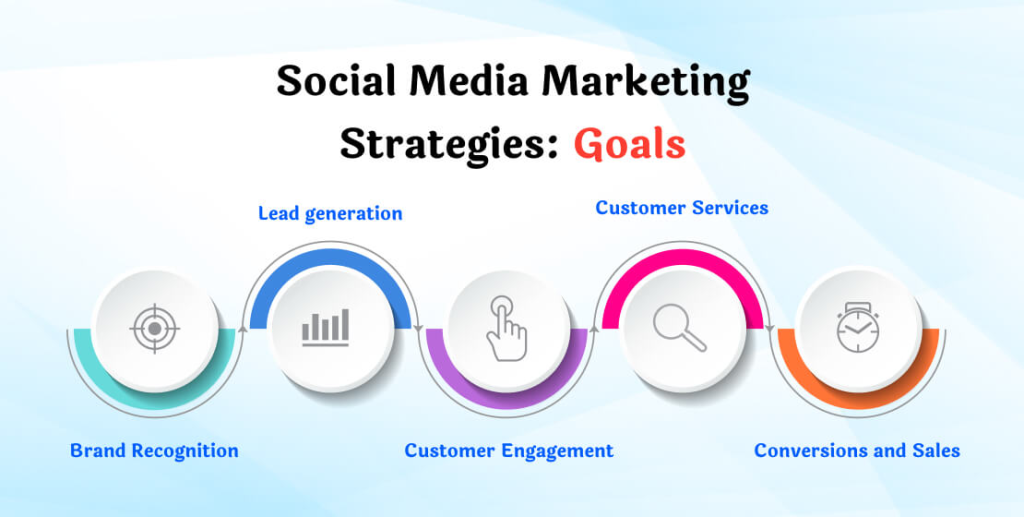Image Source: FreeImages
## Introduction
In today’s competitive landscape, having a well-defined social media marketing strategy is essential for businesses to thrive. With the ever-increasing number of platforms and content available, it’s crucial to have a focused approach that aligns with your goals and target audience. This comprehensive guide will take you through the process of creating a social media marketing plan from scratch, providing you with the insights and tools needed to succeed in 2024 and beyond. Let’s explore Title: Mastering Social Media Marketing in 2024: A Comprehensive Guide.
Researching Your Target Audience and Selecting Your Networks
To create an effective social media marketing strategy, it’s essential to understand your target audience and choose the right platforms to reach them. Instead of making assumptions, leverage social data to gain valuable insights. With the right tools, marketers can quickly research their audience without the need for formal market research or data science expertise.
Different platforms attract different audiences, so it’s crucial to consider the demographics and user behavior of each network. Here are some key statistics for 2024 that can guide your platform selection:
- Instagram: With 3 billion active users worldwide in 2023 and projected growth to 1.4 billion in 2024, Instagram remains a popular platform, especially among younger demographics. It’s ideal for businesses that can showcase their products or services through visually appealing content.
- Pinterest: More than 60% of Pinterest’s global audience is women, and it is particularly popular among Gen Z and Millennials. The platform is known for its inspirational and visual content, making it suitable for businesses that want to tap into the social selling trend.
- LinkedIn: As the hub for in-depth and industry-specific content, LinkedIn is an excellent platform for B2B lead generation. It is widely used by professionals and decision-makers, making it an essential network for businesses targeting a business audience.
- TikTok: With 1 billion users as of September 2021, TikTok has become one of the most popular apps globally. Its hyper-personalized algorithm and viral trends make it an effective platform for brands looking to connect with younger audiences.
- YouTube: As one of the most popular search engines, YouTube offers immense potential for businesses to reach a wide audience. With billions of monthly users across various languages and countries, it is a go-to platform for video content.
While these statistics provide insights into the demographics and user behavior of different platforms, it’s crucial to analyze your own audience data to determine the most suitable platforms for your business.
Picking Networks for Your Social Media Marketing Strategy
With over 15 social media platforms to choose from, it’s essential not to spread yourself too thin. Instead of trying to dominate every platform, focus on those that make the most sense for your industry and target audience. Conduct thorough research on your existing social media audience to identify which networks they are most active on.
Using a social media dashboard like Sprout’s analytics can provide a comprehensive overview of your audience demographics and activity on each channel. This data will help you prioritize your efforts and ensure that you are investing time and resources in the right networks. Additionally, leverage other valuable audience data sources such as Google and email analytics, CRM data, and customer service platforms to supplement your social media insights.
While bigger brands with large customer bases may have a presence on multiple platforms, mid-size or small businesses should focus on platforms that align with their target audience and resources. It’s important to remember that not all social platforms are suitable for every brand, so narrowing down your choices can help you allocate your time and efforts effectively.
Let’s take a quick overview of some major social platforms and their characteristics:
As one of the most widely used social media platforms, Facebook is a must-have for brick-and-mortar businesses targeting local customers. It offers features such as check-ins and reviews, making it an ideal platform to grow a dedicated local following. While Facebook’s algorithm has evolved over time, its ad platform remains the gold standard for social media ads, helping businesses cut through the noise and mitigate the impact of algorithm changes.
Instagram, centered around visual content, is a major hub for brick-and-mortar businesses, e-commerce shops, and influencers. It encourages brands to get creative and find unique ways to showcase their products or services. With features like hashtags, tagging, brand voice, and social media etiquette, Instagram is an excellent platform for mastering the social media marketing basics.
LinkedIn is a network primarily focused on business trends and networking. It is a goldmine for professionals, making it an essential platform for B2B lead generation and industry-specific content. Leveraging LinkedIn for content distribution and lead generation can provide significant benefits for businesses, especially those operating in the B2B space.
With over 465 million monthly users, Pinterest is a popular platform, particularly among Gen Z and Millennials. It is known for its visual pinning and inspirational content, making it a great network for social selling. Businesses can leverage Pinterest to showcase their products or services and inspire users to make purchases.
YouTube

While not traditionally considered a social network, YouTube boasts a highly engaged community and is the go-to platform for video content. With billions of monthly users across various languages and countries, YouTube offers immense potential for businesses to reach a wide audience. If your business is already producing video content, YouTube is an excellent platform to house and promote your videos.
TikTok
TikTok’s explosive growth has made it one of the most popular apps globally. Its short-form video format, viral trends, and hyper-personalized algorithm provide a unique opportunity for brands to connect with younger audiences. Leveraging TikTok marketing can allow businesses to engage with customers in an entirely new way.
When selecting platforms for your social media marketing strategy, consider your target audience, industry, and the unique characteristics of each platform. By focusing on the most relevant networks, you can optimize your efforts and maximize your impact.
Creating and Curating Engaging Social Content
Content is the backbone of any successful social media marketing strategy. To create an effective content strategy, consider your goals, target audience, and brand identity. Your content should align with your objectives and resonate with your audience. Here are some tips and ideas to help you define your content strategy:
Defining Your Content Strategy
Your content strategy should align with your goals and address the needs and interests of your target audience. Whether you’re looking to educate your audience, promote e-commerce products, or provide customer service, your content should be tailored to meet those objectives. Consider the following strategies:
- Educational Content: Publish blogs, news, and opinions relevant to your industry to educate your audience, particularly in the B2B space.
- Product Promotion: Showcase your products or services through action shots, product photos, and user-generated content to drive e-commerce sales.
- Customer Service: Provide tips, shout-outs, and company updates to enhance your customer service and engage with your audience effectively.
Regardless of the type of content you create, using hashtags can help increase visibility and encourage users to share their experiences with your brand.
Finding Your Brand Voice

To stand out on social media, it’s crucial to define a distinct brand voice. Your brand voice should reflect your company’s values, personality, and tone. Whether it’s a quippy and casual tone like Discord or a more professional and authoritative tone like LinkedIn, it’s important to present yourself as human and relatable. Adopting a consistent brand voice and style that aligns with your business can help you build a strong and memorable presence on social media.
Sticking to Content Themes
Consistency is key when it comes to social media content. By using consistent content themes, you can create a cohesive and recognizable brand identity. Consider cycling between different content formats and creative touches while maintaining a defined color scheme or visual style. This approach helps you stay consistent and enables you to develop a content strategy that resonates with your audience.
Content Ideas for Social Media Marketing in 2024
To create engaging content, it’s essential to understand what your audience wants. According to The Sprout Social Index™, consumers find original content and direct engagement more memorable than simply following trending topics. Therefore, it’s crucial to strike a balance between original and timely content. Here are some social media trends to consider:
- Stories and Time-Sensitive Posts: Stories-style content is highly interactive and creates a sense of urgency, making it a valuable tool to capture your audience’s attention. Stories allow you to take your followers behind the scenes, providing a more personal and authentic experience.
- Short-Form Video: Short-form videos, popularized by platforms like TikTok and Instagram Reels, continue to dominate social media. Consumers find short-form videos more engaging and pay more attention to them compared to long-form content. Leverage the power of short-form videos to create engaging and shareable content.
- Authentic and Personal Content: Remind your followers that there are humans behind your brand by sharing personal and personable content. Authenticity is highly valued by consumers, so focus on creating original and relatable content that resonates with your audience.
- Collaboration with Creators: Tap into the creator economy by collaborating with content creators and influencers. This can help drive traffic to your website, produce compelling content, and inspire purchase decisions. Choose creators who align with your brand values and have experience and authenticity in their content.
Before creating content, conduct a competitive analysis to gain insights into your competitors’ strategies. While it’s essential to be unique and authentic, understanding what works for your competitors can provide valuable insights and help you differentiate yourself in the market.
Making Your Social Presence Timely and Responsive
Timeliness is crucial in social media marketing. Consistently putting out fresh and relevant content while engaging with your audience is essential to stay top-of-mind. Here are some strategies to maximize your schedule and ensure timely and responsive social media presence:
Assemble Your Content Calendar
Use a content calendar to plan and organize your social media posts. Having a clear schedule helps you avoid posting the same content too frequently and ensures that you have a variety of content types and themes. Tools like Sprout’s scheduling and publishing feature can help you centralize your social media content and streamline your posting process.
Post at Optimal Times for Engagement
Posting at the right times can significantly impact your social media engagement. While there are general best practices, it’s crucial to consider when your target audience is most active and available. Tools like Sprout’s interactive best times to post feature can help you identify the optimal posting times specific to your industry and network.
Respond to Customer Questions and Shout-outs Promptly
Promptly responding to customer inquiries and shout-outs is vital for building strong relationships and providing excellent customer service. While it may be challenging to manually respond to every message, you can leverage AI technologies and automation to handle basic inquiries and provide immediate responses even when your team is offline. Chatbots and automated replies can help you maintain timely and efficient customer support.
Evaluate and Improve Your Social Media Strategy
Regularly evaluating the performance of your social media strategy is essential to make data-driven improvements. Monitoring key metrics and analyzing the success of your campaigns allows you to make informed decisions and optimize your future strategies. Utilize social media analytics tools like Sprout’s reports to gain insights into your top-performing content, audience engagement, and overall growth. Sharing these insights with your team and other departments can help align your social media efforts with broader business goals.
Leveraging Cross-Department Collaboration
Social media teams have unique insights into customer sentiment and can provide valuable information to other departments within your organization. By fostering collaboration across departments, you can leverage social data to drive impactful initiatives. Here are some departments that can benefit from social data:
Human Resources
Collaborate with the HR department to develop social-first employer brand initiatives. By leveraging social media for recruiting purposes, you can attract qualified candidates while showcasing your company culture and values.
Sales
Share social media insights with the sales team to help them understand customer conversations and behaviors. By connecting social efforts to sales results, you can demonstrate the value of social media in driving business goals.
Product and Merchandising
Use social media data to identify product or merchandising opportunities. By listening to customer feedback and requests, you can align your product development and merchandising strategies with customer needs.
Customer Care

Collaborate with the customer care team to improve social customer service. By monitoring customer service metrics and leveraging AI and automation tools, you can enhance your support strategies and provide timely and efficient customer care.
By leveraging social data and fostering cross-department collaboration, you can maximize the impact of your social media efforts and drive results that benefit your entire organization.
Conclusion
Creating a successful social media marketing strategy requires careful planning, research, and adaptability. By understanding your target audience, selecting the right platforms, creating engaging content, and maintaining a timely and responsive presence, you can build a strong social media presence that drives business growth. Continuously evaluating and improving your strategy, as well as leveraging cross-department collaboration, will ensure that your social media efforts remain effective in 2024 and beyond. Stay ahead of the curve by embracing the power of social media and using it to its full potential.
Remember, the key to success lies in understanding your audience, staying true to your brand voice, and consistently delivering valuable and engaging content. With these principles in mind, you can master social media marketing in 2024 and create a lasting impact for your business.

